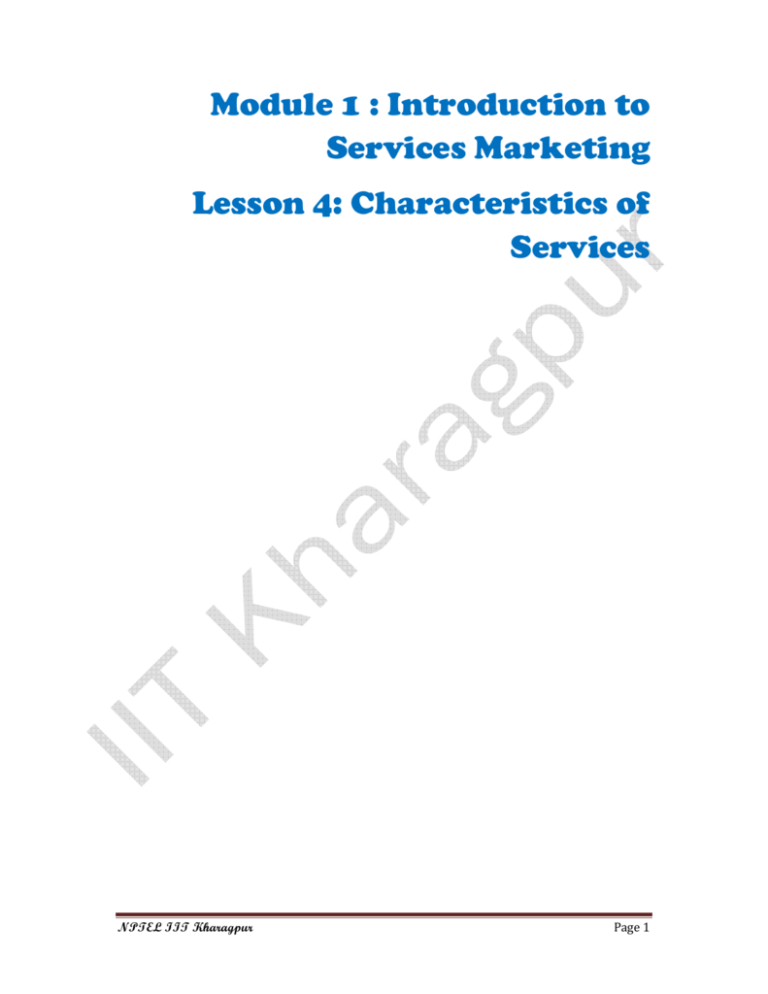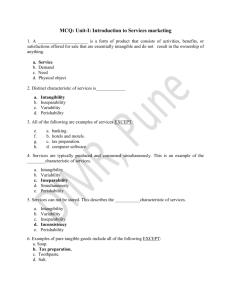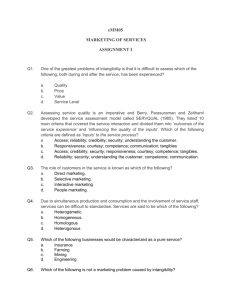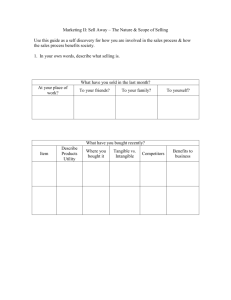Module 1 : Introduction to Services Marketing Lesson 4
advertisement

Module 1 : Introduction to Services Marketing Lesson 4: Characteristics of Services NPTEL IIT Kharagpur Page 1 Content 4.1 Introduction 4.2 Keywords 4.3 Definition of Services 4.4 Characteristics of Services 4.5 Concluding Remarks 4.6 Questions 4.7 Answers NPTEL IIT Kharagpur Page 2 4.1 Introduction In this lesson we will learn about the definition and the characteristics of services. 4.2 Keywords definition, characteristics 4.3 Definition of Services As early as 1963, Regan defined professional services as activities, benefits or satisfactions which are offered for sale, or are provided in connection with the sale of goods. In 1987, researchers Quinn, Baruch and Paquette wrote that services include all economic activities whose output is not a physical product or construction, they are generally consumed at the time they are produced, and provide added value in forms that are essentially intangible. We have also read in Error! Reference source not found. that in the ISO 9000: 2000 standard, a service has been defined as the result of at least one activity necessarily performed at the interface between the supplier and customer and is essentially intangible. Services can thus be defined as those activities that provide intangible benefits and experiences to customers while transforming their possessions. Services are basically meant to help customers in getting what they need. In 2004, Lovelock and Gummesson wrote that services could be considered as some sort of rental for using the plant, equipment, manpower or possessions of the service supplier. For example, we can avail ourselves of housing services by taking the house of the supplier on rent. Similarly, when we get our document photocopied at a shop, the price we pay consists of the cost of the paper and ink, which are tangible products, and the price (or rent) of temporary usage of the shopkeeper’s photocopier, stapler, shop, etc. 4.4 Characteristics of Services Let us now understand the characteristics of services. The two primary characteristics of services are intangibility and simultaneity. These primary characteristics lead to two secondary characteristics, namely, perishability and variability. These characteristics are discussed in the following sub-sections. Intangibility We have read an example in Error! Reference source not found. in which your friend performs the activity of giving a message to our mother. This activity of our friend, meant to help you fulfil your need, is called a service. This activity is intangible as the activity cannot be touched. This type of intangibility is called palpable intangibility. While goods are tangible products, services are those activities that provide intangible benefits and experiences to customers while transforming their possessions. For example, a hotel provides intangible benefits like shelter and rest along with a host of experiences while transforming the guest’s possessions (mind, body, clothes, etc.). Software products also possess the characteristic of palpable intangibility. Although software has been characterised as intangible product (ISO 9000: 2000), software (or information related) businesses like information technology services, architectural service, advertising service, etc., have been traditionally categorized as service businesses. Hence, intangibility is a primary characteristic of services. What are the implications of this service characteristic? Customers are unable to know and understand what will be delivered by a particular service business from its name alone. They require audio-visual communication regarding the service to understand it better. They are unable to judge the quality of the service unless tangibles cues are presented to them. For instance, IDBI bank has to illustrate through an advertisement that it is trustworthy. HSBC bank communicates that it caters to the different needs of different types of people through another advertisement. MasterCard communicates why its credit cards are worth possessing through its “Priceless” set of advertisements. NPTEL IIT Kharagpur Page 3 Secondly, as the physical facilities act as a cue used by a customer to estimate the level of service quality, service organisations have to build and maintain their facilities (i.e. servicescapes) and visual merchandise at a level consistent with the level of service they wish to deliver and charge for. Intangible services can be transformed into tangible products. For instance, recorded music, insurance, counselling or architectural design services, etc., can be consumed for a long period once the intangible service has been embedded or transformed into tangible products or possessions like audio tapes, insurance deeds, modified mental states, blue prints, etc., in order to offer long-term services to customers. Simultaneity What is the next primary characteristic of services? Service delivery and consumption are inseparable from each other and must be produced and consumed simultaneously. As we know, we have to be in the class on time to learn what the instructor is teaching there. If we arrive late, we miss part of the lecture. Then, we have to depend on the notes taken by our class mates to learn about what was taught. This is because one cannot receive a service after the service is over, unless the intangible service has been tangiblised into some form of tangible product like our friend’s class notes. Hence, services are delivered and consumed simultaneously. This is the primary characteristic of services. Other forms of products, like hardware, software, or processed materials can be stored for later use and do not have to be produced and consumed simultaneously. So, simultaneity of production and consumption is a primary and unique characteristic of services. What are the implications of this characteristic of services? As services must be delivered and consumed simultaneously, service personnel and customers must interact with each other during the process of service delivery. As customer requirements consist of both what is delivered and how it is delivered, it is important for service personnel to carefully note what customers require and deliver it to them. As customers care about how the service is delivered, service personnel must take extra care about how they behave with customers during their interactions with the latter. Although service providers might find an opportunity to correct a service after it has been incorrectly delivered the first time, this process can result in inefficiencies and involve unnecessary expenditure and poor reputation. Perishability Since services must be produced and consumed at the same time, these cannot be stored for future use, unless these are converted into tangible forms. We have to listen to a concert when it is being played. Alternatively, the concert can be recorded into a tangible form in a CD and we can listen to the CD later on. However, the tangible CD is a hardware product and ceases to be a pure service. It can, at best, be part of a service, but not the service itself. So, services perish once they are delivered. Hence perishability is a characteristic of services. Services would not be perishable unless they were simultaneously produced and consumed. Hence the perishable characteristic of services stems from its primary characteristic of simultaneity as described in section 0 above. We can now remember that perishability is a secondary characteristic of services. Other product forms like hardware and processed materials also perish after some time gap. Hence, perishability is not a unique characteristic of services. However, a service perishes as soon as it is delivered and cannot be stored in the form of an intangible service for future consumption. Once again, let us explore the implications of this service characteristic. As services embody simultaneity and perishability, the service must be delivered when the customer visits the servicescape. Customers generally visit a service organisation at some time of the day, while there would be no customers at other times of the day. We can understand this phenomenon by observing how facilities like restaurants get overcrowded during lunch and dinner times but have low loads during other times. The service manager has to match the supply of service with its demand in order to satisfy customers. However, in order to keep his resources working uniformly throughout the business hours, he has to entice customers to purchase and consume services during off-peak NPTEL IIT Kharagpur Page 4 periods. This is why, restaurants like McDonalds offer ‘Happy Hour’ discounts to customers who consume their services during off peak periods. Variability Since services are intangible, these are variable too. You may have noticed how services provided by stewards in airplanes vary from airline to airline. Similarly the services provided by restaurants vary from time to time. Services would not be variable unless they were intangible. Variability of services stem from its intangibility characteristic. Hence, variability is a secondary characteristic of services. Since, products can also suffer from variability; it is not a unique characteristic of services. Using a service-good analysis, Professors Langford and Cosenza illustrated in 1998 that an automobile insurance policy is an intangible service, which is not characterised by inseparability (simultaneity), heterogeneity (variability) and perishability. They argued that intangible benefits of the insurance policy (like asset protection, peace of mind, and credit worthiness) are consumed throughout the policy period extending much beyond the moment of purchase. However, an insurance policy is a case of a long-term continuous service that remains dormant, and the benefits remain latent, until they are claimed. The service regains its simultaneity as soon as the claims are initiated. The service perishes as soon as the policy (service) term is over. Variability creeps in during the interactions between customers and service providers, particularly when service personnel have not been trained to provide standardised services. These service characteristics give birth to quality issues as perceived by customers (see Table Error! No text of specified style in document.-1). Simultaneity of the delivery-consumption process automatically draws attention to the quality of the interaction that takes place at the interface between the server and the customer. Brady and Cronin (2001) found the quality of interactions between service providers and customers to be an important factor in determining service quality. Other authors have illustrated the importance of assurance, empathy (Parasuraman, Zeithaml and Berry, 1988), and care (Lewis, 1991) in influencing customers’ perception of service quality. Similarly, Brady and Cronin (2001) opined that customers use tangible cues from the condition of physical facilities, merchandise, and other articles present in the servicescape to evaluate the quality of services being delivered. Customers are generally unhappy to wait for services that are temporarily unavailable as a consequence of inadequate resources such that no service provider is ‘free’ to attend them (Taylor, 1994). Thus, perishability dictates that service providers must be responsive to customer demands and provide timely services (Parasuraman, Zeithaml and Berry, 1988). Many authors have stressed that reliability, dependability, credibility, consistency and accuracy (Parasuraman, Zeithaml and Berry, 1985) must be enhanced in order to reduce the inherent variability of services. Table Error! No text of specified style in document.‐1: Service characteristics and quality issues Primary characteristics Quality issues Intangibility Tangible cues (environment, tangibles, etc.) Simultaneity Interactions (Unique characteristic) (assurance, empathy, care etc.) Secondary characteristics Perishability Provide service right first time to avoid recovery Variability Reliability, dependability, credibility, consistency, accuracy (Conditional characteristic) NPTEL IIT Kharagpur Page 5 The service characteristics listed in Table Error! No text of specified style in document.-1 provide an opportunity for customizing services to suit customer requirements. In order to satisfy customers, their expectations must be accurately estimated and addressed through appropriate service design and delivery mechanisms (Morris and Johnston, 1987). 4.5 Concluding Remarks In this lesson we have discussed the definition and characteristics of services. Intangibility, simultaneity, perishability and variability are characteristics that distinguish services from other product forms. We have discussed how these service characteristics affect the quality of services delivered by an organisation. Now that we have understood the nature of services and its delivery, it is time learn the methods of identifying service business opportunities available in the society. We shall discuss this issue in the next chapter. 4.6 Questions Q1. Define services with the help of an example. Q2. List the primary and secondary characteristics of services. Q3. How do various service characteristics affect the quality of services being delivered? Illustrate with the example of restaurant or repair service. 4.7 Answers Q1. Define services with the help of an example. Answer: Services can be defined as those activities that provided intangible benefits and experiences to customers while transforming their possessions. For example, banking services provide customers the benefit of keeping their money safe and accruing interest on them. In this way, customers of a bank receive intangible benefit when their wealth gets transformed by remaining in safe custody and accruing interest on the principal amount. Q2. List the primary and secondary characteristics of services. Answer: Intangibility and simultaneity are primary characteristics of services. Services are intangible as it cannot be touched. Services are to be delivered and consumed simultaneously. Perishability and variability are secondary characteristics of services. As services are to be produced and consumed simultaneously and are intangible in nature, these cannot be stored for future use unless the service is tangiblised into a tangible product. As services are produced and consumed at the same time the delivery of a service varies from time to time, unless the service is delivered by personnel trained on a service script or the service is provided by a machine like an ATM. NPTEL IIT Kharagpur Page 6 Q3. How do various service characteristics affect the quality of services being delivered? Illustrate with the example of restaurant or repair service. Answer: Services are intangible, so customers cannot touch and feel a service before it is actually delivered. Hence, customers have to be provided with a sample of the service, so that they are able to understand the quality of the service. In case of restaurant or repair service, a customer cannot understand the quality of the service unless he/she experiences the service at least once. In order to give cues about the quality of the service, service providers communicate tangible cues like clean, shinning, well decorated and painted facilities and equipment to the customers. They might also give a free sample service, to communicate the quality of the service they provide. Services are delivered and consumed simultaneously during interactions between the customer and service personnel. In order to ensure that the interactions deliver value and are of a high quality, service personnel have to rehearse and practice the service script several times before delivering the actual service. They have to focus not only on what they deliver to customers, but also how they do so. For instance, restaurant and repair personnel have to learn and perform the service courteously with the customers; otherwise customers would be offended and dissatisfied with the service. Service personnel must learn to deliver the service with empathy and care to the customers. Services are perishable in nature. So services have to be tangiblised in the form of video demonstrations, tape records, testimonials, etc. so that customers can feel the quality of the service even when the actual service is not being delivered. As services perish once it is delivered, any mistake in the service provision would call for redoing that part of the service, which is called service recovery. Service recovery can lead to unnecessary expenditure for the service provider. So service providers have to learn and practice delivering the service right first time and each time. In short, they have to ensure that the services they provide are reliable in nature. Services are variable in nature as these are intangible and simultaneous in nature. Hence, the same service delivered by different people varies and the service provided by the same person at different times varies from time to time. Hence, service personnel have to learn the service script well and deliver the service strictly as per the service script in order to minimise the variability of the service and increase its reliability, dependability, credibility, consistency and accuracy. Customers perceive the restaurant service as reliable when they provide the same quality and level of service each and every time the customer purchases the service from the restaurant. NPTEL IIT Kharagpur Page 7







